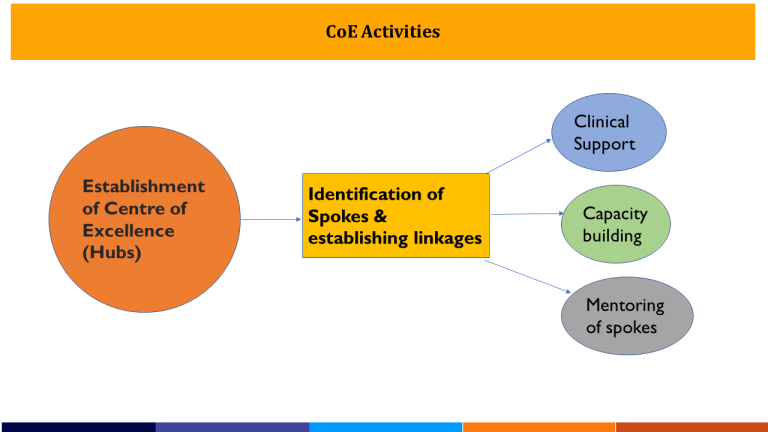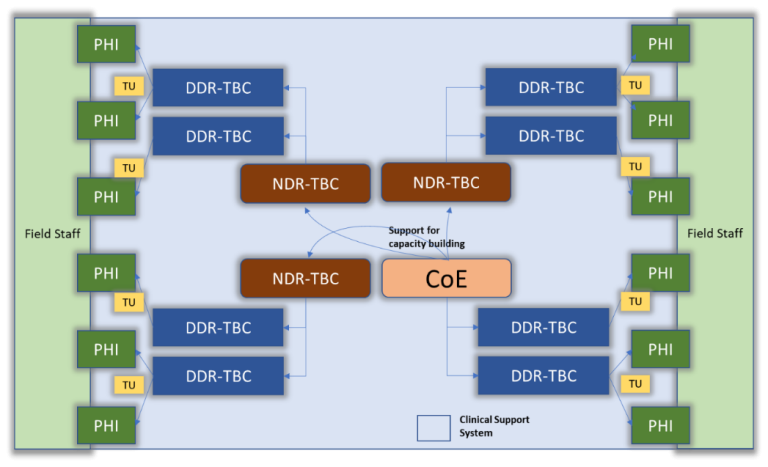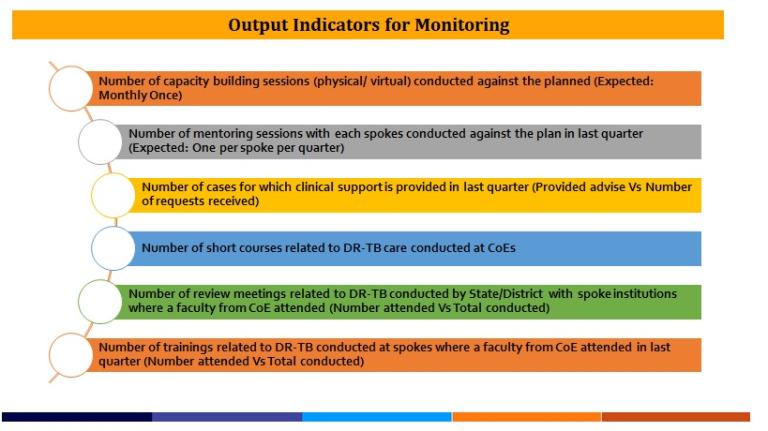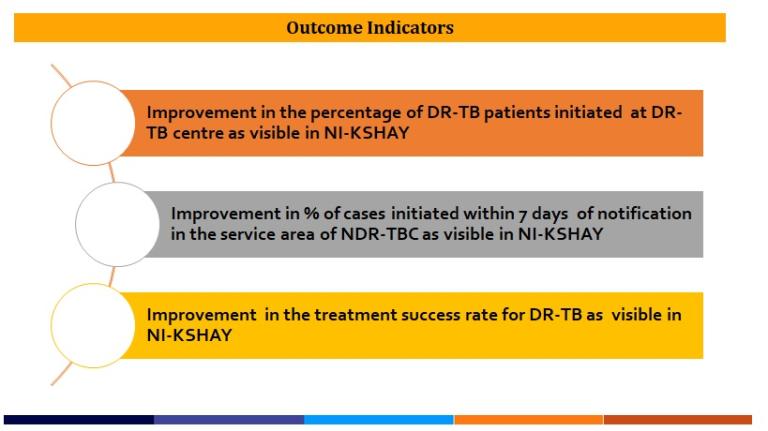Framework for DR-TB Institution Strengthening using CoEs
Framework for DR-TB Institution Strengthening using CoEsThis document provides guidance to:
- identify and recognize institutions as CoEs
- CoEs to conduct activities that strengthen TB/ DR-TB clinical care institutions that are linked under them.
Background
BackgroundThe NTEP is committed to fulfill India’s contribution to the global achievement of the targets set by the first ever United Nations High level meeting on TB (UNHLM-TB) in September 2018 by successfully treating 11.47 million people with TB, including 1.13 million children and 439,660 people with DR-TB; and initiating 6.9 million people on TPT by 2022. India has rolled out an ambitious National Strategic Plan (NSP) for the period 2017-2025.The NTEP is also now focused on the important element of institutional strengthening and has proposed the concept of institutional strengthening, especially through establishment of Centres of Excellence (CoE) under the recently drafted Revised National Strategic Plan (NSP) to End Tuberculosis in India 2020–2025 .Since the commitments made in the United Nations High Level Meeting (UNHLM-TB) in 2018, nearly 8 million people with TB were notified and 6.74 million people were successfully treated during 2018 and 2021, including 323,677 children. During the same period, out of 222,513 people with DR-TB diagnosed, 189,023 people with DR-TB were put on treatment and 1.9 million people were initiated on TPT .
NTEP will adopt a hub and spoke model approach to demonstrate institutional strengthening through identified national and state level institutes. The project will augment capacities and efficiencies of strategic TB and DR-TB Care institutes as “Hubs” that will impact the program implementation at the linked institutes and geographies - the “Spokes”. This model allows for the rapid spread of knowledge, tools, and evidence, while simultaneously providing guidance and mentoring for the spoke institutions, to offer standards of excellence. Hub institutions will play a critical role in diffusing skills and expertise across the public and private healthcare facilities to increase efficiencies across a range of institutions.
A range of institutions provide DR-TB care under NTEP. This includes medical colleges, tertiary health care centres, teaching institutes, laboratories and hospitals in public and the private sector. There are close to 150 NDR-TB and 500 DDR-TB Centres situated in national institutions, medical colleges, tertiary care institutes and district hospitals. With an intention to improve the quality of DR-TB care in terms of early and complete identification of DR-TB, to initiate all diagnosed cases on appropriate treatment timely and ensure follow up of all patients to ensure successful treatment completion, the project has been supporting NTEP in establishing a hub and spoke model through establishment of Center of Excellence in DR-TB care. These CoEs are envisaged to demonstrate excellence in DR-TB care by providing distinct care to complicated TB/DR-TB cases using advanced diagnostics, new combination of medicines, aDSM, adverse drug reaction (ADR) management, surgical interventions, psychosocial support, rehabilitation and palliative care. In addition, these CoEs will innovate and demonstrate best practices in clinical management, treatment adherence and infection prevention and control.
The proposed CoEs will mentor linked NDR-TB Centres and support replication of the best practices-based care models. Eventually, CoEs will also support NTEP in policy decisions, development of guidelines, generating evidence, and development of implementation tools and job-aids.
NTEP will work with identified institutions and improve service delivery, learning, knowledge management, analytics, gender sensitivity and monitoring & evaluation capacity. This will be achieved through critical gap filling for infrastructure, human resources, capacity building, technology, and partnerships. The project intends to demonstrate improvement in DR-TB care through institutional strengthening, with CoEs and linked institutions and geographies. The project support will result in establishment of functional CoEs and demonstrating institutional strengthening through hub and spoke model engaging CoEs, NDR-TB and DDR-TB Centres. The project also intends to support documentation and dissemination of best practices and to create a community of practice for institutional strengthening.
Mission & Objective of the CoE for TB/DR-TB care
Mission & Objective of the CoE for TB/DR-TB careMission:
To offer dynamic, comprehensive, and innovative learning experience that will enable health care providers to expand their knowledge and enhance their professional skills to provide uniform high standards of care to the people affected with Drug Resistant TB (DR-TB), in a HUB and SPOKE Model.
Objectives:
- To advance the quality of DR-TB clinical care across the country through establishment of a CoE program in a Hub and spoke model
- To build the capacity of Nodal and District DR-TB Centers (N/DDRTBCs) for providing uniform high- quality DR-TB care through continued education, mentorship and short clinical courses.
- To provide expertise and clinical opinions for Difficult to Treat TB cases
- To demonstrate DRTB program components like Pulmonary rehabilitation, Palliative care, Thoracic surgery care for which there are no good models exists in the country
Expectation from CoEs on DR-TB care
Expectation from CoEs on DR-TB careThe Programmatic Management of Drug Resistant TB (PMDT) Guidelines of National TB Elimination Program (NTEP) establish the requirements of a Nodal DRTB Centre (NDRTBC) at the level of excellence. The CoE can be considered as a model NDRTB center that has achieved the level of excellence or more prescribed in the PMDT guidelines.
-
A CoE will be an institution with a designated Nodal DRTB center and has achieved and consistently maintains, advanced TB and DR-TB clinical expertise as prescribed in the Programmatic Management of DR-TB guidelines (PMDT) and provides the state-of-the-art clinical TB and DR-TB services to its patients. A CoE is also a recognized academic center, where new knowledge and expertise in TB and DR-TB care/management is constantly being generated and disseminated.
-
The CoE can be established in a Medical College or in Institute of National Importance (INI) such as National Institute of TB and Respiratory Diseases or a Tertiary Level Government Hospital.
Once an institution has been designated as a CoE, it would be expected that it contributes to NTEP by supporting the linked spokes on the following:
-
Support in capacity building & mentoring: CoEs are expected to
-
provide experts for training and capacity building sessions for trainings organized by NTEP.
-
provide clinical opinions for Difficult to Treat TB cases referred to CoEs from the linked DRTBCs, either physically or virtually
-
conduct short clinical courses for medical professionals in DR TB care
-
mentor the linked DRTBC to ensure that its patients are receiving the highest quality of care.
-
-
Research & Evidence Generation: CoEs are expected to support in advancing quality of clinical care across the country through evidence generation.
-
Demonstration of program components: CoEs will also support NTEP in demonstrating DRTB program components for which there are no good models exists in the country. Eg. Pulmonary rehabilitation, palliative care, Thoracic surgery care etc.
Proposed Components of CoE program
Proposed Components of CoE programProposed Components of CoE program are:
A. Establishment of Centre of Excellence (Hubs)
B. Identification of Spokes & establishing linkages
C. Clinical Support, Capacity building and mentoring of Spokes by the CoEs

A. Establishment of Centre of Excellence
A. Establishment of Centre of ExcellencePrerequisite for a CoE in DR-TB care is that it should have a well-functioning designated Nodal DR-TB center.
Potential institutions are expected to have the following essential features:
Sustained Patient load: The Centre due to its reputation and service offerings should attract a sustained patient load for DR-TB related services in both inpatient as well as outpatient departments.
Diagnostic services: Comprehensive diagnostic services for all types TB and DR-TB, including laboratory, radiology and clinical methods should be accessible to all patients reaching a CoE. Patients reaching the center should be receiving all necessary diagnostic services as per guidelines of NTEP.
TB Treatment Services: The Centre should have the capacity to initiate all types of drugs and regimen available under the program. All investigations for Pre-Treatment Evaluation should be available at a CoE. They should be able to assess progress to treatment and promptly adjust or modify the treatment regimen as per NTEP policy as needed. Facilities for managing DR-TB in patients of all ages, pregnancy and other special conditions should be present. In cases where patient shows indication of treatment failure/ intolerance or recurrence of TB/DR-TB and in complicated or difficult to treat cases, the center should have demonstrated ability to design appropriate regimen.
Adverse Drug Reaction management: The Centre should have demonstrated ability to manage all types of ADRs.
Comorbidity Management: There should be facilities to diagnose/ workup and manage all types of TB comorbidities.
Counselling Services: The Centre should have demonstrated ability to inform and educate patients about diagnosis, treatment, ADR and prognosis of their condition using services of expert counsellors in a non-discriminatory and inclusive manner.
Recording and reporting: The center should have a robust system for creating and maintaining clinical records of its patients along with prompt update of details in Ni-kshay as necessary.
Infrastructure and HR:
•Airborne infection control measures: These center should comply with AIC guidelines
•In-patient and Outpatient Services: The Center should have dedicated inpatient and outpatient departments for TB/ DR-TB. Outpatient services should be available throughout the week during working hours.
•Human Resources: The center should have in-place and trained human resources as per the guidelines and norms of NTEP with an emphasis on gender-responsive recruitment.
•DRTB Committee: It should also have a functioning DR-TB committee that meets regularly and provides consultation for its cases.
•Critical Care: The center should have ability to deal with critically ill patients due to TB/ DR-TB. This may be in the form of a TB Intensive Respiratory Care Unit with appropriate infection control measures and facilities or other methods to provide intensive life support and related care.
•Research and evidence generation: The Centre may be performing various studies or research in clinical, technological, operational or implementation areas.
It is highly desirable for a CoE to have the following
•Advanced diagnostic/ Treatment protocols –NTEP diagnostic and treatment protocols are standardized to consider the programmatic conditions that will be applicable all over the country. The Centre, however, may not be limited by this. They may adopt diagnostic and treatment protocols that are above and beyond the recommendations of the program to provide a more wholesome care to its patients. These need to be done with adequate approvals, documentation and rationale, and experiences from such extensions should be studied and published either as case studies/ series or as trials.
Advanced Surgical care in TB requires both advanced facilities and surgical expertise. These include lung resections, extra pleural thoracoplasty, extra pleural pneumolysis, thoracomyoplasty, pleurectomy and decortications of the lung; and so on.
Palliative care: The Centre should be able to provide appropriate palliative care for patients with disability, advanced disease or poor prognosis related to TB as described in PMDT guidelines 2021. The Centre should have demonstrated ability to perform palliative care either in-house or through linked services.
Pulmonary Rehabilitation: The Center should have a good pulmonary rehabilitation service catering to the needs of patients.
B. Identification of spokes & establishing linkages
B. Identification of spokes & establishing linkages10-15 spokes will be mapped with each CoEs. The selection of the spokes would be as per the following criteria: The spoke institution should be
•A designated Nodal/District DR-TB Centre
•Willing and committed to be a part of the spokes network of the concerned CoE.
•At a reachable distance with the CoE in a selected geography.
The CoEs (Hubs) will provide support to all the DR-TBCs (spokes) that are linked to it in a Hub and spoke model as illustrated below. The CoE and its linkages with NDR-TBCs will be identified by CTD in concurrence with the states and revised from time to time, as new CoEs are established.

C. Clinical Support, Capacity building & Mentoring of Spokes by Hub
C. Clinical Support, Capacity building & Mentoring of Spokes by HubThrough the hub and spoke model, the CoEs will provide support to the linked Spokes (N/DDR-TBCs) in
1. Clinical Support
2. Capacity building and
3. Mentoring.
The details are as follows:
1.Clinical advice: CoEs need to provide clinical advice for the Difficult to Treat cases referred to them form the NDR-TBCs. The referral will mostly be virtual where the provider seeks expert opinion from the CoEs through virtual interaction platforms. The virtual advice shall also be provided through the Difficult to Treat TB clinics (D3TC).
Suggestive models for Remote Clinical Consultations
i.Scheduled care model – Remote consultation that has a periodic predetermined schedule (Weekly/Monthly).
ii.Responsive (Reactive) care model or case based – Reactive, episodic care, which is usually unscheduled.
The above models can be delivered through two structures:
a)Clinical Consultation through Virtual Interaction Platforms: CoEs need to organize a monthly virtual session with spokes to discuss complicated cases. Such sessions could be organized more frequently based on the need.
b)Documented response to clinical queries: NDRTBCs can also raise queries to CoEs through their designated emails/other mechanisms. CoEs need to provide documented response to such queries.
.
Scope and advantages of Clinical Consultation through Virtual Interaction Platforms
•CoE will help in providing the expertise to remote areas and extend their expertise more quickly and easily by eliminating time and geographic barriers.
•CoEs and tertiary care facilities will be less over-burdened with premature/inappropriate referrals, if those cases could be managed properly at DDRTBCs. This will minimize patient inconveniences and promote quality care in a patient centric manner.
•Actionable decision support by CoEs would improve treatment outcome.
•Virtual Interaction Platforms will also establish a network between the mentoring and mentee in the region, thus going a long way in streamlining the process of referrals and back-referrals.
2.Capacity building: The CoE need to run regular capacity building sessions such as those related to newer updates, addressing common pitfalls/ gaps in DR-TB care practices, for its linked spokes. This need to be done as (a) monthly one-hour capacity building session through virtual interaction platforms (b) short courses and (c) observer ships programs
a)Capacity building through virtual interaction platform
Capacity building through virtual interaction platforms could be organized in the following ways.
1. Case based interactive sessions: Real-life case-based scenarios will be discussed by CoEs with spokes on a monthly basis to ensure cross-learning and selecting appropriate treatment plan.
2.Guidelines updates: Time to time update of recent management guidelines could be organized by CoEs
3.Strengthening Programmatic components: CoEs will use virtual interaction platforms to build capacity of spokes in programmatic components such as counselling, mental health assessment, managing co-morbidity, identification and management of ADRs, recording and reporting and data quality assurance.
4.Infection prevention and control (IPC): Sensitization of doctors and nurses towards AIC practices and biomedical waste management
b) Short Courses
CoEs to design and conduct short courses for the staff of spoke institutions. Courses need to focus mainly on the components which are not well demonstrated in DR-TB care such as TB Thoracic Surgery, Palliative care and Pulmonary Rehabilitation.
c) Observership
A plan for Observership can be developed by each CoE for the healthcare personnel of the spokes. Medical officers, nurses could be posted in the CoE for Observership.
Apart from the clinical exposure, these personnel will benefit from:
1. Participation in academic activities at CoE
2. Participation in daily bedside rounds by Faculty
3. Observation during bedside procedures and interventions
4. Separate daily academics for observers by Medical and nursing personnel can focus on:
a. Counselling for patients and family
b. Identification and management of Adverse Drug Reactions
c. Mental health and de-addiction
d. Nutritional status assessment & nutritional counselling
e. Air borne infection control
3.Mentoring to improve quality of care: CoEs need to mentor and handhold the spokes to improve in the quality of DR-TB service delivery.
This could happen through the following methods:
a.The CoEs need to conduct one-to-one virtual mentoring sessions with each of the identified spokes once in three months to address pertinent problems specific to that spoke and to suggest quality improvement interventions. During the mentoring sessions, staff of spokes could raise specific questions related to clinical or programmatic components of PMDT and seek guidance from the experts at CoEs. CoEs could also look at the areas for improvement in the spokes in relation to DR-TB care and suggest potential solutions. Key staff involved in patient care, NTEP Key staff of the institute along with administrative staff from spokes could participate in such mentoring sessions.
b.Experts from CoE need to attend the DR-TB review meetings organized by state/district NTEP, identify the potential issues, help them in performing a root cause analysis by looking at the processes and suggest possible solutions to address the priority problems.
c.Faculty from the CoEs need to visit the spoke institutions along with the state/ district NTEP officials during supportive supervisions and internal evaluations.
Process for the designation of Centre of Excellences for DR-TB care
Process for the designation of Centre of Excellences for DR-TB careNomination, Assessment & Designation of CoEs
Nomination for the potential institutes to be sent by the State to Central TB Division (CTD). An assessment will be conducted by a team of experts constituted by CTD. Based on the assessment report and other necessary consideration, CTD would recommend a center as a CoE for DR-TB care. For centers where essential gaps have been identified by the assessment team, the institutes can rectify the gaps and reapply.

Operational Framework for CoEs (Hubs) & Spokes
Operational Framework for CoEs (Hubs) & Spokes•The day-to-day administration of the CoE and its functions will be the responsibility of the concerned institution; the NDR-TBC committee at CoE may govern the functioning of the CoE.
•Head of the Institution would oversee the CoE activities and may nominate a chest physician as nodal officer for operational aspects.
•CoE would also be supported by the NTEP key staff (Medical Officer, Statistical Assistant, Counsellor for NDRTBC and additional Medical Officer, Lab Technician, TB Health Visitor if it’s a medical college) already posted at the institution.
•Overall coordination between HUB and SPOKES would be carried out by NTEP Medical Officer/staff posted in the CoE under the guidance of Nodal Officer.
•DRTBC committee at the Spokes will be responsible to ensure participation of spokes in all the activities. Head of the institution may nominate a chest physician as nodal officer for operational aspects at spokes. The NTEP Key staff (Medical Officer, Statistical Assistant, Counsellor for NDRTBC and additional Medical Officer, Lab Technician, TB Health Visitor if it’s a medical college) at NDRTBC and District Senior DRTB coordinator need to support the activities of the spokes as per the guidance of the Nodal Officer.
•All CoEs & spokes need to be equipped with virtual interaction platforms.
Capacity building of Hubs & Spokes
Capacity of clinicians, nursing personnel and health care providers of the CoE in the areas of DR-TB care need to be built.
CTD will coordinate specific trainings on:-
(1) Programmatic Management of DR-TB in India
(2) Counselling skills
(3) Mental status assessment of DR-TB patients
(4) ADR management
(5) Airborne Infection Control
(6) Data management for the identified staff at CoEs enabling the trainees to manage DR-TB in more efficient and competent manner and also to train others. CoEs need to plan the cascade trainings within the institute in co-ordination with the state NTEP.
Routine training of all staff at SPOKE institutions need to be undertaken through state NTEP & State TB Training & Demonstration Centers (STDC) with the help of the facilitators from the CoE.
Recording and Reporting
All patient related data to be entered in NI-KSHAY at both hubs and spokes on a real time basis. Apart from the records and documents mentioned in the PMDT guidelines, a proper log of documentation of the referrals, consultations, capacity building and mentoring sessions held (phone logs/e mail record/ video interaction logs) should be maintained at all Hubs and Spokes. A quarterly report need to be prepared by the Statistical Assistant/NTEP Key staff at the CoE and submitted to Central TB Division through the State TB Officer.
Financial Assistance
NTEP has provided a Senior Medical Officer, a Statistical Assistant, and a Counsellor at all NDR-TBC. In addition, all medical colleges have the provision of MO-Medical College (1); TB health visitor (1) and Lab Technician from the NTEP program. Their services could be utilized for conducting various activities as CoEs. Establishment of virtual interaction platforms at all hubs and spokes will be temporarily supported through the developmental partners working with NTEP. Diagnostics and treatment services including drugs for DR-TB management will be provided to the hubs and spokes as per the norms of NTEP. There are no other additional resources required for a CoE /spokes other than that required for an ideal NDRTBC. If the institution requires additional resources to demonstrate any of the components of an ideal NDR-TBC, the resources could be mobilized from various sources including state health budget, NHM PIPs, support from the developmental partners working for institutional strengthening, various project-based funds/grants or through CSR grants/ support.
Ancillary/Support Services for CoEs & Spokes
Ancillary/support services like lab, radiology, drugs for managing co-morbidity/adverse drug reactions, CSSD, mechanized laundry is ideally available in the facility and should be made available to the DR-TB patients also.
Monitoring & Evaluation - Centre of Excellences for DR-TB care
Monitoring & Evaluation - Centre of Excellences for DR-TB careMeasuring the output, outcome and impact of CoE for DR-TB care program
The program should envisage the measurement of output of the CoEs for DR-TB care and also try to assess the impact of the program. Some suggested parameters could be:
1.Output Indicators:
•Number of capacity building sessions (physical/ virtual) conducted against the planned (Expected: Monthly Once)
•Number of mentoring sessions with each spokes conducted against the plan in last quarter (Expected: One per spoke per quarter)
•Number of cases for which clinical support is provided in last quarter (Provided advise Vs Number of requests received)
•Number of trainings related to DR-TB conducted at spokes where a faculty from CoE attended in last quarter (Number attended Vs Total conducted)
•Number of review meetings related to DR-TB conducted by State/District with spoke institutions where a faculty from CoE attended (Number attended Vs Total conducted)
•Number of staff trained from spokes out of the existing staff in last one year
•Number of short courses related to DR-TB care conducted at CoEs

2.Outcome Indicators:
•Improvement in % of DR-TB patients initiated on treatment at district DR-TB center (NI-KSHAY)
•Improvement in % of cases in the service area of NDR-TBC whose DR-TB treatment initiation was done within 7 days of notification (NI-KSHAY)
•Improvement in treatment success rate for DR-TB (NI-KSHAY)

3.Impact Indicators:
•Change in the compliance of spokes to PMDT guidelines (measured using a structured tool every two years)